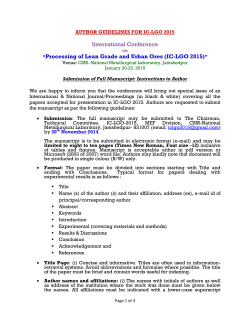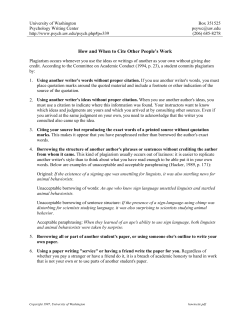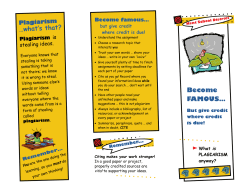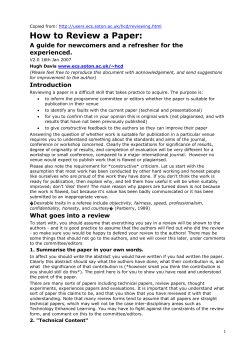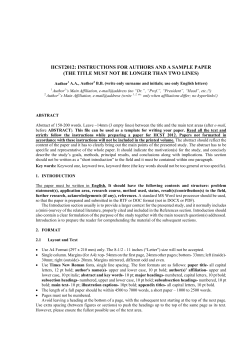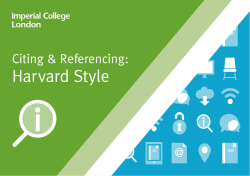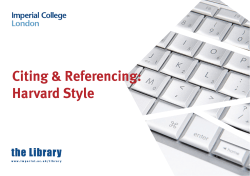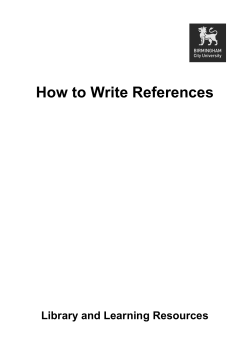
Citing and Referencing in the Harvard Style
Citing and Referencing in the Harvard Style For all academic assignments it is vital that you acknowledge the sources of information you have used for your research. This will help you protect yourself against charges of plagiarism and also demonstrate that you understand the importance of professional academic work. You must acknowledge your sources whenever you paraphrase or summarise another person's ideas or points, or when you quote another person's work, or use tables, graphs, images, etc. which you have found from another source, be it from a printed document or from the web. This guide explains how this is done in the Harvard Style, sometimes called the author-date system. There are two steps to acknowledging your sources: cite your references in the text, to show where you have drawn upon other people's work, and then list them at the end of your work under the heading 'References'. Sometimes this is called a bibliography. Some Schools may adopt slight variations on the methods suggested below; please check your Handbook. Citing your sources in the text When you refer to another’s words or ideas in your work, you must cite your source. At an appropriate point in your text, provide the author’s surname and the year of publication in round brackets. If you include the author’s name in your sentence, only provide the year of publication in brackets: It has been argued (Harris 2001) that the main considerations are… It has been argued by Harris (2001) that the main considerations are… For edited books that contain collections of chapters written by different authors, cite the author of the chapter and not the editor of the overall book. If you are citing different publications written by the same author in the same year, label the first one cited with the letter ‘a’ after the year and the second ‘b’ etc. e.g. (Smith 2004a), (Smith 2004b). You will need to do the same in your list of references. Where two authors have produced the work, include both their last names in your citation e.g. (Cullingworth and Nadin 2007) or Cullingworth and Nadin (2007). When there are three or more authors use the abbreviation et al. (and others) after the first author’s surname e.g. Tayler et al. (2003) or (Tayler et al. 2003). If you are discussing a point about which several authors have expressed similar views, include them all in one set of brackets in chronological order of publication. List any works published in the same year in alphabetical order e.g. (Midgley 1994; Smith 1994; UNCHS 1996; Gandelsonas 2002). Paraphrasing your sources The examples above cover instances where you are summarising the overall argument or position of a book or an article. If you are paraphrasing a particular argument or point from your source you must include page numbers: It has been argued (Harris 2001, pp. 20-21) that the main considerations are the scope of the project, the cost and the duration of the work. Directly quoting from your sources You should aim to paraphrase information provided by an author in your own words rather than quote large amounts of their work verbatim as this helps to demonstrate to the reader your understanding of the information. It can be necessary to quote directly from the text when you: Cannot present the information more succinctly or in any other way. Need to present a particular portion of an author’s text in your work to analyse it. If the quotation is short, enclose the writer’s words in double quotation marks and then cite the author, date and page number: Key causes of economic deprivation include low income or unemployment which are often the result of “poor qualification levels and lack of basic skills” (Thake and Saubach 1993, p. 18). Longer quotations should be separated from the body of your text and indented from the left-hand margin. When you indent a quotation, there is no need to include quotation marks: As Joia and Sanz (2005, p. 5) observe: In specific terms, it might be imagined that the benefits of web consumer retention would only seem to be advantageous for digital companies that are client-centric, which can interact with these consumers. Furthermore, the mere fact of using transactional practices, low differentiation between products and the emphasis on promotion of price on the web would seem to increase sensitivity to price. In the current fiercely competitive internet commerce climate it would seem that these observations might well be borne out. If you omit some words from the quotation, you need to indicate this by typing in three dots, e.g. “The state has an essential role … in the legal definition of property rights” (Deininger 2003, p. 69) If you add some of your own words within the quotation, place your words in [square brackets] to make it clear which are the author’s words and which are yours. Remember to quote exactly as the words appear in the original: do not add bold or italics. Referencing Referencing means giving a full description of each source you have cited in the text, in a list of references or bibliography, at the end of your work: Write the list in alphabetical order: put the first author’s last name first and then his/her initials. Include the names and initials of all authors or, if there are more than two authors, use the abbreviation et al. after the first author’s name. Arrange any references with the same author by the year of publication, beginning with the oldest. Titles should be italicised for books, reports and conference proceedings. For journal articles, the title of the journal (not the title of the journal article) should be printed in italics. Capitalise the first letter of each author’s last name and each initial. Also capitalise the first letter of the publication title written in italics, the first letters of all main words in the title of a journal and all first letters of a place name and publisher. For further help or information contact your nearest library. See www.cardiff.ac.uk/insrv/libraries/locations References Abel, R. 2004. The eye care revolution: prevent and reverse common vision problems. New York: Kensington Books. Ang, L. and Taylor, B. 2005. Managing customer profitability using portfolio matrices. Journal of Database Marketing and Customer Strategy Management 12(5), pp. 298-304. Ballinger, A. and Clark, M. 2001. Nutrition, appetite control and disease. In: Payne-James, J. et al. eds. Artificial nutrition support in nd clinical practice. 2 ed. London: Greenwich Medical, pp. 225-239. Benoit, B. 2007. G8 faces impasse on global warming. Financial Times 29 May 2007, p. 9. European Commission. 2004. First report on the implementation of the internal market strategy 2003-2006. Luxembourg: Office for Official Publications of the European Communities. Book. Journal article. You can reference both print articles and their electronic equivalents in this way. Chapter from an edited book. Begin with the author and title of the chapter. Also, provide the chapter page numbers. Newspaper article. Include the day and month of publication. Online versions can also be referenced like this. Report. If there is no individual author, use the name of the organisation. Fledelius, H.C. 2000. Myopia and significant visual impairment: global aspects. In: Lin, L.L.-K. et al. eds. Myopia Updates II: th Proceedings of the 7 International Conference on Myopia. Taipei, 17-20 November, 1998. Tokyo: Springer, pp. 31-37. Conference paper. Include the date and location of the conference. Garcia-Sierra, A. 2000. An investigation into electronic commerce potential of small to medium-sized enterprises. PhD Thesis, Cardiff University. PhD thesis. For a Master’slevel work, you’d write ‘MSc/MA Dissertation’. Merchant, A.T. 2007. Diet, physical activity, and adiposity in children in poor and rich neighbourhoods: a cross-sectional comparison. Nutrition Journal [Online] 6. Available at: http://www.nutritionj.com/content/pdf/1475-2891-6-1.pdf [Accessed: 10 May 2007]. Thompson, B. 2006. Why the net should stay neutral [Online]. Available at: http://news.bbc.co.uk/1/hi/technology/4594498 [Accessed: 10 May 2007]. Electronic journal article. If a journal is only available online, use this instead of journal article. Journal issue numbers and pages may be omitted if not available. Web page. See additional notes for web sources on page 4. For further examples of referencing other types of sources including eBooks, DVDs and blogs see the Cardiff University Harvard style FAQs at http://ilrb.cf.ac.uk/citingreferences/tutorial/faq.html For further help or information contact your nearest library. See www.cardiff.ac.uk/insrv/libraries/locations Other points Publication dates and editions To find out when a book was published look at the back of the title page. This page will contain details of the publisher and the publication date. If there is more than one date, use the latest publication date, not the latest reprint date. This is often located next to the © symbol. If no publication date is given put [no date] in the citation and the reference, e.g. (Smith [no date]). The back of the title page will also tell you the edition of the book. If the book you are acknowledging is not the first edition, state this in the full reference but not in the citation in your text. e.g.: nd Kattàn-Ibarra, J. and Pountain, C.J. 2003. Modern Spanish grammar: a practical guide. 2 London: Routledge. ed. Web sources Referencing a web source can be difficult. If no author is given, web pages can be referenced by the organisation responsible or by the title instead. A good web site should, however, have sufficient ownership information to enable you to cite it. If no ownership is detectable, you should question whether the source is of sufficient quality. Ideally you should aim to include the following information: Author (if available) or Organisation. Publication Date. Document title [online]. Place: Publisher (if available). Available at: web address of document [Accessed: date you viewed the site]. e.g. Lane, C. et al. 2003. The future of professionalised work: UK and Germany compared [Online]. London: Anglo-German Foundation for the Study of Industrial Society. Available at: http://www.agf.org.uk/pubs/pdfs/1232web.pdf [Accessed: 5 July 2007]. If an electronic source has no page numbers you can identify a quotation by giving a paragraph number in your citation instead, e.g. (Koernig 2003, para. 17). Secondary referencing Where possible you should aim to reference from the original source. However, sometimes you may need to cite an author whose work you have not personally read, but whose work is presented or summarised by the author of a publication you have consulted. This can be shown as follows: Rondinelli (1983), cited in Potts (2002, p. 37), describes the stages of a project… or A process project might consist of a number of stages including experimentation and production (Rondinelli 1983, cited in Potts 2002, p. 37). In your references you should list the source you have actually read, i.e. Potts. Advice on avoiding plagiarism For guidance on plagiarism, visit the Academic Integrity web site at www.cf.ac.uk/regis/sfs/academic/ . A short online tutorial on Avoiding Plagiarism is available at http://ilrb.cf.ac.uk/plagiarism/tutorial/ . INF-057/ Q / 12 / October 2013 / RM - Also available in alternative formats. For further help or information contact your nearest library. See www.cardiff.ac.uk/insrv/libraries/locations
© Copyright 2025

